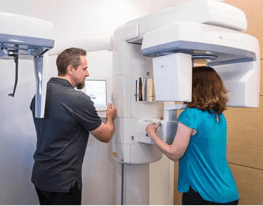What is a Nerve Root Sleeve Injection?

A Nerve Root Sleeve injection (NRSI) is an injection of local anaesthetic and/or steroid into the sheath around the nerve. The injection is done to alleviate pain of the nerve caused by inflammation, post-surgical scarring, arthritis in an adjacent spinal joint, or other less common causes.
Please inform the booking staff if you are on Warfarin, Plavix, or any other blood thinning agents, or have any other medication allergies.
Nerve Root Sleeve Injection
What happens during a Nerve Root Sleeve Injection?
A. Before your NRSI
What to bring
- Your request form
- Any relevant previous imaging
- Your Medicare card and any concession cards
Preparation – In the week before your procedure
You must advise us of any blood-thinning medication your are taking such as Aspirin, Warfarin, Plavix or Iscover and stop taking it for a period of time before your treatment. Please contact us for advice.
Preparation – On the day of the procedure
You will be asked to fill out a questionnaire regarding your health status, medication, and any known allergies. If there is any chance you may be pregnant, please inform us before your scan. You may also be asked to change into a gown and remove some jewellery for your scan.
B. During your Nerve Root Sleeve Injection
Procedure
When you are transferred to the CT room you will be made comfortable on the examination table. The examination table slides you into the centre of the CT machine and some preliminary pictures are taken to confirm the scan position and the area of needle entry marked on your skin.
The skin above the nerve root will be washed with antiseptic and a local anaesthetic may be injected. A fine needle is then inserted, guided into position using CT control and once satisfactorily positioned the solution will be injected.
Your procedure will take about 20 minutes.
Risks and side effects
CT-guided NRSI is a very low risk procedure. Find out about CT Risks and Side Effects.
Other risks associated with this procedure include:
- Pain or discomfort at the needle insertion site, or bruising after the procedure.
- You may experience numbness or weakness in the distribution of the nerve that has been injected, lasting for up to a few hours.
- Infection is rare but may involve redness or swelling and increased back pain, usually after 48 hours. Superficial infection is the most common form and responds rapidly to antibiotics; deep infection is extremely rare, but can be severe and associated with pressure on the spinal nerves that may require surgery. Increasing back or neck pain needs to be promptly reported to us and your referring doctor.
Any medical procedure can potentially be associated with unpredictable risks.
Who will perform my procedure?
Our experienced medical imaging team will perform your Nerve Root Sleeve Injection.
Nerve Root Sleeve Injection
What happens after a Nerve Root Sleeve Injection?
Post-procedural information
After the injection the needle is removed and compression will be applied to the needle insertion site. The local anaesthetic may cause numbness in your leg (lumbar NRSI) or arm (cervical NRSI) which can last for between 4-8 hours. This sensation usually presents immediately, and if it has not developed within ½ hour, will not at all. Staff will monitor you until normal sensation returns. Pain relief can take a few days to develop and may be temporary (lasting weeks or months), or permanent.
You must have someone pick you up after the injection as you will not be permitted to drive yourself home. Further Post-Procedural Information can be found here.
Post-Procedural Information

Nerve Root Sleeve Injection
Downloads
Medical Imaging Practice Perth
Types of Imaging
At Envision, we offer the most sought-after types of imaging for diagnostics and treatments. Our Wembley headquarters is the largest single-site radiology practice in Perth







